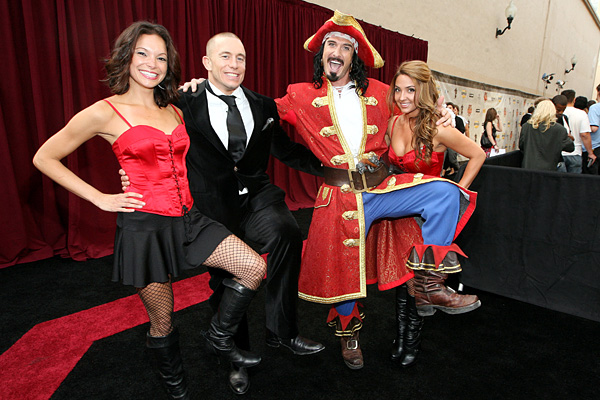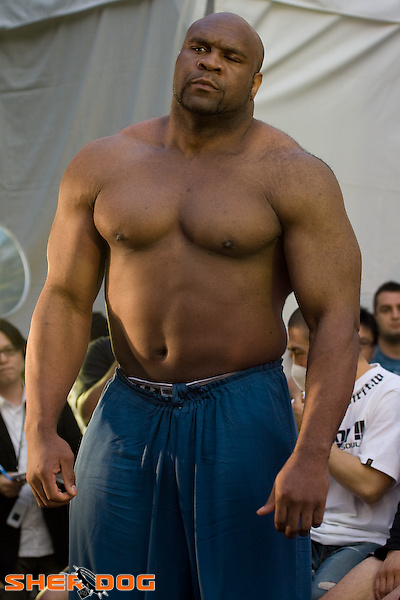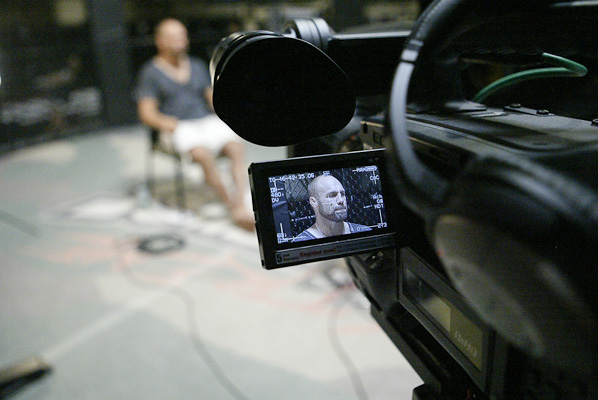MMA at 20: Going Mainstream

MMA
and its athletes have become surprisingly visible pop culture
symbols. | Casey Rodgers/AP Images/Captain Morgan
With most spectator sports, there is a gradual entrance into broader pop culture. Baseball and hockey were simple diversions long before they became popular enough to become the subjects of books, films and songs. They grew naturally on their own, decades prior to their depictions in fictional settings. This was not the case with the young, unique sport of mixed martial arts. MMA is the rare sport that grew out of pop culture.
In the United States, the first Ultimate Fighting Championship events played on fan interest in how martial arts disciplines would match up against each other. That subject had been tackled in martial arts films for decades. Bruce Lee’s “Enter the Dragon” was likely the most influential of the lot, and mixed martial artists from Kazushi Sakuraba to Anderson Silva have cited Lee as an influence. However, “Bloodsport” in 1988 was perhaps the most thematically similar film to the UFC’s single-elimination, multi-discipline tournament.
Advertisement
Campbell McLaren, the executive producer of the early UFC shows, told Sherdog.com that a primary influence of those events came not from the silver screen but rather from a popular fighting video game: “I saw the UFC as a real version of ‘Mortal Kombat,’ with a karate guy versus a sumo guy versus a jiu-jitsu guy versus a boxer and so on.”
“Mortal Kombat,” itself inspired by martial arts movies with
over-the-top violence, featured a primary character, Liu Kang, who
was clearly modeled after Lee. The UFC in its early days attempted
to piggyback off the popularity of pop culture depictions of
fighting, in large part because people did not know what real, open
rules fighting looked like. When that answer was later provided, it
filtered its way back into the next generation of action films.
In Japan, mainstream MMA grew out of a different but even more culturally ubiquitous form of popular entertainment: professional wrestling. For decades, pro wrestling occupied a much more significant place in Japanese pop culture than it did in America. Early wrestling star Rikidozan drew some of the country’s highest television ratings battling foreigners like The Destroyer, Freddie Blassie and Lou Thesz. His protégés, Antonio Inoki and Shohei “Giant” Baba, dominated the scene in the following decades.
To show the cultural cache pro wrestling had in Japan, Nippon Television in 2006 released a list of history’s most influential people. “Giant” Baba ranked 63rd, ahead of Elvis Presley and Arthur Conan Doyle. Rikidozan finished 18th, above Gandhi and George Washington. The network then surveyed the Japanese public regarding its favorite people from history. Baba finished 93rd, ahead of Abraham Lincoln, Chopin and Isaac Newton. Historically, pro wrestling is one of Japan’s most popular forms of entertainment.
One of the enduring themes of Japanese pro wrestling involved native wrestlers proving their superiority against other fighting disciplines. Inoki competed in the New Japan Pro Wrestling ring against the likes of judo gold medalist Willem Ruska, karate star Willie Williams and boxing legend Muhammad Ali. Decades later, Nobuhiko Takada started in New Japan and followed a similar path to Inoki as the top star for the Union of Wrestling Forces International promotion. As the Japanese pro wrestling hero, Takada defeated the likes of boxer Trevor Berbick, sumo wrestler Koji Kitao and wrestler Gary Albright.
By 1997, Takada’s popularity had diminished, and for the first time, he entered into competition with dangerous opposition without predetermined results. Pride Fighting Championships, Japan’s most popular MMA organization, was born. When Takada proved unable to legitimately defeat quality opponents, another pro wrestler, Sakuraba, took his top spot. Pride, unlike the UFC, was to the public essentially a real version of pro wrestling. As such, it was part of Japan’s broader pop culture from the beginning.
As MMA’s popularity grew, a new generation discovered the sport, not in the context of its origins but rather as an entity unto itself. Producers, actors, directors and talent agents all became fans of the sport. However, it took quite a while before MMA had a consistent presence in American pop culture. There, serious obstacles still had to be overcome.
The UFC’s early marketing approach was part blessing, part curse. The emphasis on violence attracted much more attention than a low-key approach. It also created a backlash and made the UFC seem taboo. Early UFC pay-per-view buy rates showed that the martial arts were as popular as ever, but ironically, they felt more underground than before the UFC came along.
That climate made it all the more surprising when the UFC was featured on one of the most successful sitcoms of the 1990s -- “Friends.” The episode, which aired on May 8, 1997, remains an interesting time capsule in a number of ways. Played by future “Iron Man” director Jon Favreau, the boyfriend of actress Courtney Cox’s character aspired to become an “ultimate fighting” champion.
It was indicative of how the Ultimate Fighting Championship was perceived at the time that many of the characters knew nothing about it, and Cox’s character referred to it as an “ultimate fighting competition thingy.” Fighter David “Tank” Abbott, referee John McCarthy and UFC ring announcer Bruce Buffer all made cameos. Cox’s character ultimately broke up with her boyfriend, and the episode concluded with the implication that he lost his next fight via a series of low blows. Such strikes were prohibited in the UFC by the time the episode aired, but it fit into the image of MMA as an outlaw competition.
“Friends” represented a major break for the sport in pop culture, but it would be one of the last of its kind in America for more than a decade. The UFC ostensibly went dark, as its events lost most major clearances. MMA likewise disappeared from the American pop culture scene, save for the occasional straight-to-DVD project.
Though MMA struggled in the United States, it thrived in Japan. With the success of Pride, stars like Sakuraba, Mirko Filipovic and Wanderlei Silva secured major endorsements that showcased them to the greater Japanese public. Still, no fighter rose to greater heights than Bob Sapp. With a superhuman physique and overflowing natural charisma, Sapp drew the strongest television ratings in the history of kickboxing and MMA. He then parlayed that success into a cavalcade of television appearances, commercials and promotional endorsements. Sapp later traveled back across the Pacific for roles in major films like “Elektra,” “The Longest Yard” and “Conan the Barbarian.” He remembers those years fondly.
“The defining moment for me was when I made the cover of ‘Time’ magazine in Asia,” Sapp said. “That was a really huge accomplishment. To be on the cover of that was absolutely amazing for me, personally.”
Another American fighter who broke into the Japanese mainstream during this period was Don Frye. Frye fit the persona of the quintessential American tough guy and was offered a series of roles in Japanese and later American movies. In his most prominent assignment, he was billed third from the top in “Godzilla: Final Wars,” a 2004 Japanese film with a nearly $20 million budget.
As Japanese MMA declined in popularity following a yakuza scandal that cost Pride its Fuji TV deal, it was time for American MMA to rise to the forefront. “The Ultimate Fighter” reality series on Spike TV drew millions of viewers and legitimized the sport for many. Pay-per-view buy rates soon exploded. MMA was finally fully mainstream in America, and the line quickly formed to capitalize on the sport’s popularity. It proved advantageous for many. Directors and actors who enjoyed MMA got projects involving MMA green-lit; fans who wanted to see MMA-related projects now could see them regularly released with theatrical budgets; and fighters who long sought acting opportunities in Hollywood finally were getting the roles they had pursued.
“I’d been taking meetings and reading for parts a very long time before I got a role with [director] David Mamet in ‘Redbelt,’” UFC hall of famer Randy Couture said. “With the landscape of the sport being what it is, it’s opening more and more doors all the time.”
Where just years earlier the immensely talented and charismatic Bas Rutten was pounding the concrete looking for parts in Hollywood, MMA fighters were now landing them left and right. Couture scored a featured role in “The Expendables” films opposite some of the world’s most famous action stars. Former UFC light heavyweight champion Quinton “Rampage” Jackson played B.A. Baracus in the “A-Team,” which grossed $177 million. Perhaps the most striking ascent belonged to Gina Carano. In 2011, Academy Award-winning director Steven Soderbergh made her the lead in “Haywire” as part of a cast that featured Ewan McGregor, Michael Douglas and Antonio Banderas. Carano had very limited acting experience when Soderbergh stumbled upon one of her fights, but a seed was planted in the head of the unconventional filmmaker.
“I see Gina coming out,” Soderbergh said during a Q&A session at the Lincoln Center in 2012. “She’s got the cornrows and the warrior affect. She just destroyed this woman in the cage. I hadn’t seen anything like this. I just filed it away. I thought it was fascinating.”
Though “Haywire” was not a smash by any means, it was telling that Soderbergh could get the project approved with such an unknown acting commodity in the lead role. Carano later lined up a featured part in the box office hit “Furious 6.”
Soderbergh was not the only director struck by the MMA world. Three major feature films about the sport were released in just the past five years.
Mamet, who wrote “Glengarry Glen Ross” for the theater and the screen and penned the screenplay for “The Verdict,” became enamored with jiu-jitsu and MMA. When the playwright moved to Los Angeles, “Married with Children” and future “Modern Family” star Ed O’Neill introduced him to the world of jiu-jitsu. “I was enthralled,” Mamet said, “not only by the sport and by the art of jiu-jitsu but by the community.” Mamet gave back to that community with “Redbelt,” an MMA-themed film that featured Couture and Hawaiian light heavyweight Enson Inoue. The movie was well-received by critics but struggled at the box office.
Gavin O’Connor’s film, “Warrior,” was even better received by critics and earned an Academy Award nomination in 2011. Including cameos from the likes of Nate Marquardt, Anthony Johnson, Roan Carneiro and Erik Apple, it fell into the straightforward sports genre, much like “Bull Durham,” “Any Given Sunday” and O’Connor’s previous movie, “Miracle.”
The third MMA film of the period was “Here Comes the Boom,” which starred Kevin James and was directed by Frank Coraci, of “The Waterboy” and “The Wedding Singer” fame. James is one of Hollywood’s most ardent MMA fans, and his positive relationship with the Ultimate Fighting Championship led to the promotion’s decision to lend its brand name to the project. Many UFC stars – including Wanderlei Silva, Rich Franklin, Chael Sonnen and Brian Stann – were brought in for cameos, while Rutten, Jason “Mayhem” Miller, Mark Munoz and Krzysztof Soszynski received more prominent roles. In some ways, the project was a strange companion piece to the episode of “Friends” a decade and a half earlier. Like that episode, the movie centers on an unlikely fighter’s lighthearted attempt to make it in the UFC.
As MMA leaves its formative years behind, pop culture figures to play a diminished role in shaping the direction of the sport. However, it will likely continue to reflect the nature and popularity of MMA, as well as providing opportunities for some of the sport’s biggest stars. Many of the more current breakthroughs would have seemed unthinkable just a few short years ago, which leaves plenty of room for future growth.
Related Articles










